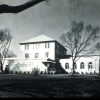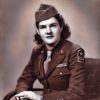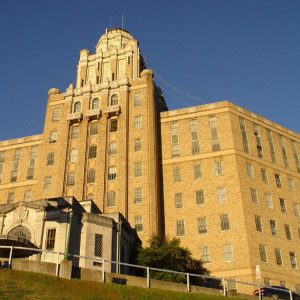calsfoundation@cals.org
Army-Navy Hospital
aka: Hot Springs Rehabilitation Center
aka: Arkansas Career Training Institute
The building that later became the Hot Springs Rehabilitation Center (HSRC) and then the Arkansas Career Training Institute (ACTI) began its existence as the first combined general hospital for both U.S. Army and Navy patients in the nation. The Army-Navy Hospital was created ahead of the Navy Hospital Corps and over twenty years before the founding of the Walter Reed Army Medical Center. The facility in Arkansas was quite an economic and social boon for rural Arkansas in the eyes of America and remains an imposing presence on the local skyline, regularly featured in pictures of the community.
In the early 1800s, people believed that bathing in mineral waters had therapeutic value, which brought many people to the town of Hot Springs (Garland County). The groundwork for the hospital was proposed at an 1882 dinner party on the second floor of the Palace Bathhouse in Hot Springs. The party was given by Dr. A. S. Garnett, a former Confederate army surgeon, honoring U.S. Senator John A. Logan, a former Union general who had served with distinction on General Ulysses S. Grant’s staff. The impressed senator said the city was “an ideal location for an institution of this character” and promised to introduce legislation for an appropriation upon his return to Washington DC. By the end of June, $100,000 was approved for the building of a thirty-bed, joint military hospital, the first such effort in U.S. history. President Chester A. Arthur signed the bill in 1882. The Army-Navy Hospital opened to patients in January 1887 under the direct jurisdiction of the secretary of war. It was not until 1957 that the control of the facility was transferred to the U.S. Army.
The present fireproof brick and steel facility was built in the early 1930s, replacing the 1880s version made of red brick, slate, and wood. The seven-story structure was built at a cost of approximately $1.5 million, paid for by the U.S. government.
The hospital was recognized as the army’s leading center for dealing with arthritis, and during World War II, the facility became the largest center for treating adults afflicted with polio (sometimes called infantile paralysis) in the country because of the therapeutic baths provided for patients. Between 1887 and World War II, the hospital treated more than 100,000 patients.
After World War II, military men and women were streaming back from the battlefields of Europe and the Pacific. Many who suffered severe wounds or the loss of limbs were sent to Hot Springs to take advantage of the hydro-therapy treatments. The influx of injured soldiers taxed the Hot Springs facilities. To have more beds and space for added staff, the federal government bought the Eastman Hotel across and down the street from the main hospital. A connecting ramp linked the two buildings, and the number of beds available for patients tripled almost overnight. This gave the hospital badly needed space for recreational and reconditioning projects, in addition to providing space for overnight family visitors.
Along with soldiers being treated for war injuries, servicemen from battle zones were sent to the Hot Springs facility for rest, relaxation, and rehabilitation. The Arlington and the Majestic hotels housed the overflow soldiers who could not be accommodated on the hospital base. At its peak in the late 1940s into the early 1950s, the hospital (as a federal facility) was one of the top five employers in Garland County.
The hospital’s military era ended officially on April 1, 1960, when the facility was turned over to the State of Arkansas to become a rehabilitation hospital. Hot Springs Rehabilitation Center became a state-run, full-scale rehabilitation facility run by Arkansas Rehabilitation Services, one of nine of its kind in the nation and the only one west of the Mississippi River. HSRC served people with life-long disabilities as well as those who had acquired disabilities. At HSRC, students (so designated to distance them from the stigma of being called “patients”) obtained needed rehabilitation services and were taught independent living skills necessary in society. Each student had a course of study that was laid out to meet his or her specific needs. Other support programs were available to help students prepare for living on their own.
In 2007, the building was added to the National Register of Historic Places as part of the Army and Navy General Hospital District.
Although it was licensed for roughly three times the twenty-four active beds it had in the medical wing, the demand became more for vocational training rather than medical services. This shift in demand resulted in the State of Arkansas announcing in November 2011 a plan to close the medical wing of the center. In 2009, HSRC became the Arkansas Career Training Institute (ACTI), focusing on vocational training. Ten years later, as a result of Governor Asa Hutchinson’s reorganization of state government (Act 910 of 2019), the ACTI was slated for closure at the end of 2019.
In 2020, the building was included in Preserve Arkansas’s annual list of most endangered places. The building has remained empty since then.
For additional information:
“Army and Navy General Hospital District.” National Register of Historic Places nomination form. On file at Arkansas Historic Preservation Program. Little Rock, Arkansas.
Bowen, Elliott. In Search of Sexual Health: Diagnosing and Treating Syphilis in Hot Springs, Arkansas, 1890–1940. Baltimore, MD: Johns Hopkins University Press, 2020.
Cron, Frederick W. “Hot Springs’ Military Hospital: The Army and Navy Opened One Hundred Years Ago.” The Record 28 (1987): 83–91.
Frederick W. Cron Collection. Garland County Historical Society Archives, Hot Springs, Arkansas.
Martin, Bitty. “If These Walls Could Talk: Hot Springs’ Army & Navy General Hospital.” The Record (2021): 7.1–7.18.
Showers, David. “Historic Hospital in Limbo, Mired in U.S. Red Tape.” Arkansas Democrat-Gazette, August 13, 2020, p. 3B. Online at https://www.arkansasonline.com/news/2020/aug/13/historic-hospital-in-limbo-mired-in-us-red-tape/ (accessed July 21, 2025).
———. “Officials Get Close-up Look at Historic Army-Navy Hospital Site.” Arkansas Democrat-Gazette, July 21, 2025. https://www.arkansasonline.com/news/2025/jul/21/officials-get-close-up-look-at-historic-army-navy/ (accessed July 21, 2025).
———. “U.S. Officials Tour Shuttered Army and Navy General Hospital in Hot Springs.” Arkansas Democrat-Gazette, March 22, 2024. https://www.arkansasonline.com/news/2024/mar/22/us-officials-tour-ex-hospital-site/ (accessed December 11, 2024).
Carl Enna Jr.
Arkansas Rehabilitation Services



 Army-Navy Hospital Building
Army-Navy Hospital Building 



Why is every historical building’s first fate to be destroyed. Hot Springs’ casino revenue is astronomical compared to anything the track and horses ever brought here. Tear it down? Then have a nice grass hill to look at? With today’s technology the building could be turned into literally anything. Sad to give up on U.S. history so quickly.
I was a student/patient in 1971. This facility literally saved my life. My stay there gave me the opportunity I needed to succeed in life. I am grateful for the time I spent there. It would be a shame to disregard the history of this “monumental” building by destroying it.
To lose this building would be as bad as losing the Washington Monument or Lincoln Memorial. Let’s not let that happen.